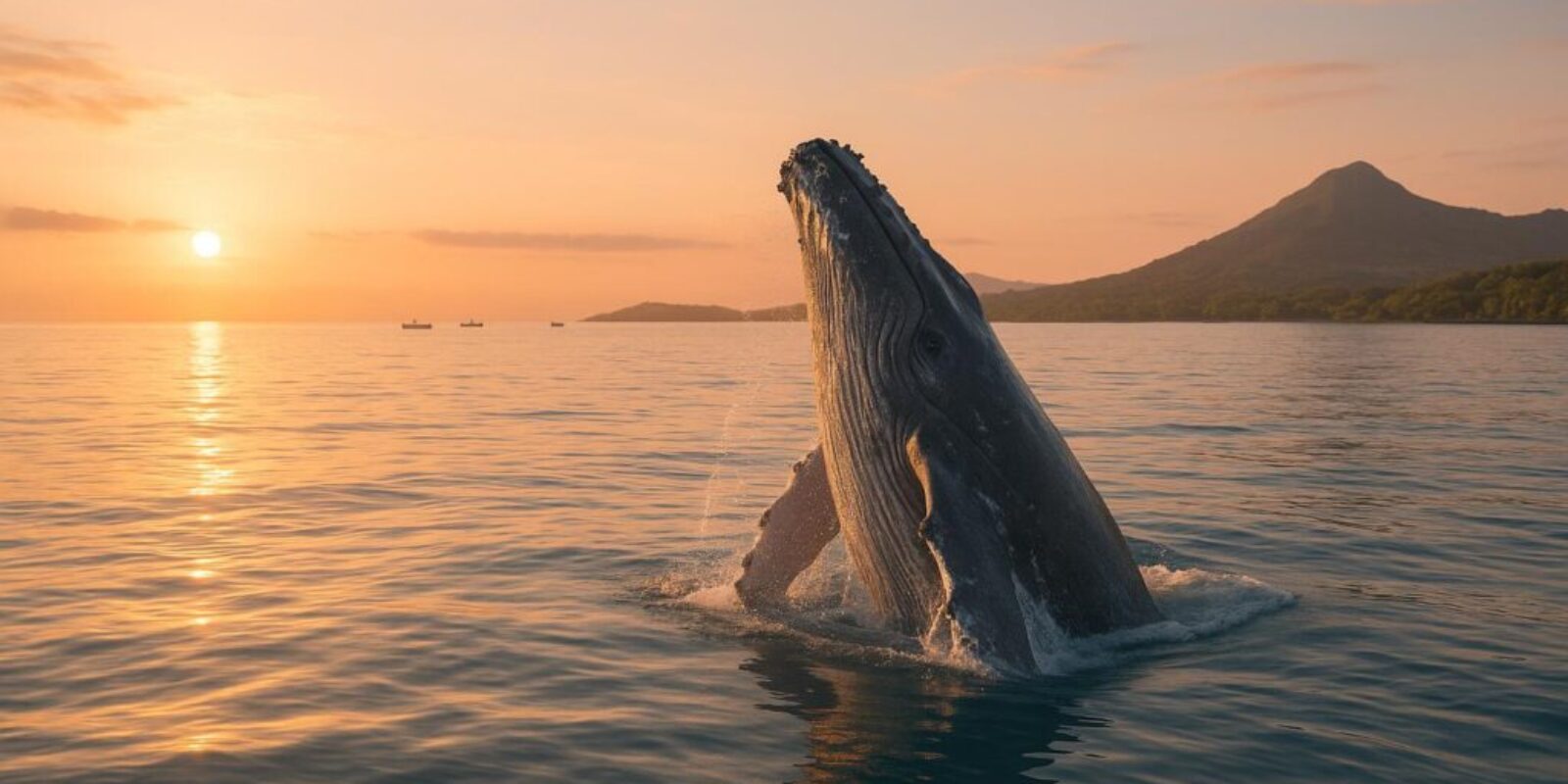If you’re planning a whale-watching trip to Mauritius, here’s what you need to know upfront:
- Best Time to Visit: June to October is ideal, with humpback whales active from July to October and sperm whales visible year-round.
- Top Locations: The west and southwest coasts, especially Tamarin Bay and Black River, are the best spots due to their proximity to deep waters.
- Timing Matters: Morning tours (6:00 AM–12:00 PM) offer calmer seas and higher chances of sightings.
- Species Highlights: Humpback whales showcase dramatic breaches and songs during their migration, while sperm whales are known for deep dives and pod behavior.
- Seasonal Conditions: Winter months (June–October) bring cooler weather, calmer seas, and better visibility, making it the most comfortable time for excursions.
For the best experience, book a morning tour during the winter months, and head to the west coast for optimal sightings of these incredible marine mammals.
Whale Watching in Mauritius
When to Go Whale Watching in Mauritius
If you’re planning a whale watching trip to Mauritius, the best time to go is between June and October. During these calmer winter months, both humpback and sperm whales are active in the surrounding waters, making it an ideal time to catch a glimpse of these majestic creatures. Here’s a closer look at when you can spot each species.
Humpback Whale Season (July to October)
Humpback whales are one of the highlights of Mauritius’s marine life during their peak season, which runs from July to October. These whales undertake an incredible migration from the Antarctic to the warmer waters of Mauritius to breed and give birth. Their annual journey is nothing short of astonishing, covering distances of over 25,000 kilometers.
This season not only brings plenty of whale activity but also offers pleasant weather conditions, making it the perfect time for a day out on the water.
Sperm Whale Sightings All Year
Unlike humpback whales, sperm whales don’t follow a strict migration pattern. They are residents of Mauritius and can be seen year-round. Often traveling in pods of 10 to 20 individuals, they provide frequent opportunities for multiple sightings during a single trip. Known for their deep dives, sperm whales can plunge to depths of 2,000 to 3,000 meters and remain underwater for up to two hours. They are most commonly spotted off the island’s western coast, where the ocean floor drops steeply into deeper waters.
Thanks to the presence of both migrating humpbacks and resident sperm whales, Mauritius offers fantastic whale watching opportunities throughout the year. However, the winter months stand out as the best time to experience a mix of species and enjoy the calm seas.
Weather and Sea Conditions for Whale Watching
The weather and ocean conditions in Mauritius play a significant role in the success of whale-watching trips. Seasonal changes impact how comfortable the experience is, how clear the waters are, and how likely you are to spot whales.
"Mauritius is considered a year-round destination for marine wildlife tourism. However, certain periods are more favorable depending on the species you wish to observe." – HI DMC
Winter Season Benefits (June to October)
From June to October, winter in Mauritius offers some of the best conditions for whale watching. During these months, cooler and drier weather combines with calmer seas to create an ideal environment. With less choppy water, boats are steadier, reducing the chances of seasickness and making it easier to keep an eye out for whales. Popular spots like Tamarin, Black River, and Le Morne on the west and southwest coasts tend to have stable conditions, though the east coast often experiences stronger winds. The predictable weather in winter also means that tour operators can plan excursions more reliably, ensuring a smoother experience for visitors.
Off-Season Conditions
The summer months, from November to April, bring more challenging conditions for whale watching. Higher temperatures and humidity contribute to rougher seas, making sightings less frequent and trips less comfortable. Cyclone risks between January and March further disrupt plans and reduce visibility. While sperm whales are present throughout the year with a 60%–70% chance of being spotted, success rates typically decline during this season. To make the most of the conditions, many operators opt for early morning outings when the sea is generally calmer.
Best Times of Day to See Whales
When it comes to whale watching, timing is everything. Not only do seasonal conditions matter, but the time of day you head out can greatly influence your experience. In Mauritius, whale watching is restricted to the morning hours, specifically from 6:00 AM to noon. Whales tend to be more active during these early hours, making morning trips the top choice for many enthusiasts. Let’s break down why early departures are preferred and how they compare to later outings.
"The best whale watches leave early, the 8am time is ideal for the most calm conditions." – Ducksdelux, TripAdvisor Contributor
Morning Tours
Most tours start between 5:30 AM and 7:00 AM. These early hours are prime time for whale watching because the sea is typically at its calmest. Calm waters not only make for a smoother ride but also improve visibility, giving you a better chance to spot whales. Boats are steadier, and the overall conditions are ideal for a memorable experience.
Afternoon Tours
Afternoon trips, on the other hand, often contend with stronger winds and choppier seas. As the day heats up, thermal winds can cause rougher waters, and whales are less likely to surface as frequently. By the time the noon limit approaches, conditions are far from optimal. For the best chance at spotting whales and enjoying comfortable conditions, aim for the earliest departure time available.
Where to Go Whale Watching in Mauritius
The west and southwest coasts of Mauritius are the go-to spots for whale watching, thanks to their close proximity to the deep waters of the Indian Ocean. These areas are ideal for observing both migrating humpback whales and resident sperm whales, especially during the right seasons.
West and Southwest Coast Highlights
The west and southwest coasts are recognized as prime locations for whale watching. Most tours set off from Grande Riviere Noire on the southwest coast, often heading toward Tamarin Bay, a well-known hotspot for whale sightings. Whale watching here is a year-round activity. Resident sperm whales are regularly spotted, and from July to September, humpback whales join the scene during their migration. The deep waters near these coasts provide an excellent environment for observing these majestic creatures up close.
Easy Access to Deep Waters
One of the biggest advantages of these coasts is their immediate access to the deep waters that whales prefer. For instance, sperm whales are known to dive as deep as 2,000 meters (6,560 feet) in search of food. Tour operators take full advantage of this proximity, offering efficient excursions. Whale Dream Ltd., for example, boasts a 90% chance of spotting whales in these waters, with resident sperm whales present throughout the year.
This easy access means shorter travel times to key whale habitats. Tours typically last three to four hours, giving participants plenty of time to enjoy unforgettable wildlife encounters.
Whale Species and What They Do
The waters around Mauritius are home to two prominent whale species, each offering unique behaviors that make whale watching an unforgettable experience. Sperm whales can be spotted all year, while humpback whales grace the area during their migratory breeding season. Together, they make Mauritius a top choice for whale enthusiasts.
Humpback Whales
Humpback whales, which can grow up to 52 feet (16 meters) long and weigh as much as 40 tons, migrate to Mauritius during the winter months to breed and give birth. One of their most captivating behaviors is breaching – a dramatic leap out of the water. You might also witness tail slapping, where their powerful flukes hit the water’s surface, or pectoral fin slapping. Another fascinating behavior is spy-hopping, where they lift their heads above the water to take a look around.
During breeding season, male humpback whales are known for their enchanting songs. These complex melodies can last up to 20 minutes and travel as far as 18 miles (30 kilometers) underwater. While humpbacks captivate with their surface acrobatics, sperm whales showcase a completely different set of skills.
Sperm Whales
Sperm whales are the deep-diving experts of Mauritius and are the most frequently sighted whales in the region. Fully grown males can measure between 49 and 66 feet (15–20 meters) and weigh up to 50 tons.
These whales are famous for their incredible ability to dive more than 3,280 feet (1,000 meters) in search of squid. Female sperm whales are deeply connected to their family groups, living in stable units of about 10–12 individuals for their entire lives. These groups communicate through distinct vocal patterns called codas. On the other hand, male sperm whales leave their groups at around 6–8 years old and often lead solitary lives.
The contrasting habits of humpback and sperm whales ensure there’s always something fascinating to observe in Mauritius’s waters, no matter the time of year.
Conclusion
To make the most of your whale watching adventure in Mauritius, aim to visit during the island’s winter months, from June to October. This period offers the perfect opportunity to see both migrating humpback whales and resident sperm whales.
The calmer seas during these months provide ideal conditions for spotting whales, with early morning excursions often offering the smoothest waters and best visibility. The west coast, with its proximity to deep waters, is the prime location to witness these majestic creatures in their natural habitat.
Whether you’re captivated by the graceful migration of humpback whales or the breathtaking dives of sperm whales, timing your trip during this season gives you the best chance for an unforgettable encounter with these ocean giants.
FAQs
When is the best time to go whale watching in Mauritius, and how can I make the most of the experience?
The ideal time to go whale watching in Mauritius is during the cooler months, from May to November, with the best chances of spotting whales typically between July and September. This is when humpback and sperm whales are more frequently seen in the waters surrounding the island.
For a great experience, opt for a responsible tour operator that adheres to ethical practices, such as keeping a safe distance from the whales and avoiding any actions that could disturb them. Be sure to bring along essentials like binoculars for a closer view, sunscreen to protect your skin, and light layers to stay comfortable throughout the trip. Respecting the wildlife and following the crew’s guidance will help make your adventure both safe and unforgettable.
What impact do different whale species have on the whale watching experience in Mauritius throughout the year?
Mauritius is a fantastic destination for whale watching, thanks to the variety of whale species that call its waters home. Sperm whales and pilot whales, which are resident species, can be seen throughout the year, offering consistent chances to spot these incredible creatures. On the other hand, humpback whales, which are migratory, make their way to Mauritius between June and November, adding a seasonal highlight to the experience.
The combination of these year-round residents and seasonal visitors ensures that whale enthusiasts can enjoy a truly dynamic and memorable encounter, no matter when they visit.
What should I know before booking a whale watching tour in Mauritius?
When planning a whale watching tour in Mauritius, it’s smart to book your trip in advance, particularly during the busy season from May to November. This is when whale sightings are more common, and booking early ensures you won’t miss out on this unforgettable experience.
Make sure to go with a reliable and experienced tour operator who prioritizes safety and ethical practices. Following local guidelines is essential – keeping a respectful distance from the whales helps protect them and ensures a responsible encounter for everyone involved.
Also, pay attention to the weather and sea conditions on the day of your tour. Mornings, when the seas are typically calmer, are often the best time for a smooth ride and better chances of spotting whales. Don’t forget to pack sunscreen, a hat, and a light jacket so you’re comfortable throughout your adventure!



